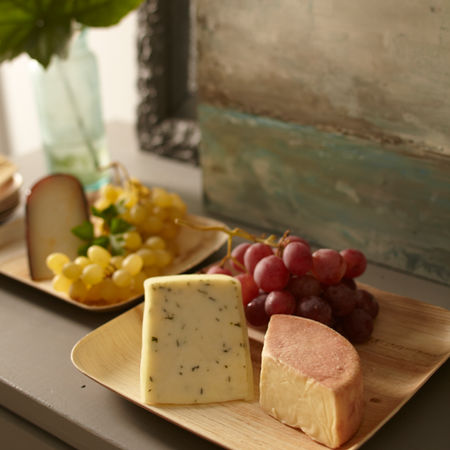
Cheese
Cheese is a dairy product made from curdled milk, offering a wide range of flavors, textures, and aromas depending on its type, aging process, and the milk used (cow, goat, sheep).
From soft and creamy varieties like Brie and Mozzarella to hard and sharp types like Cheddar and Parmesan, cheese is incredibly versatile in cooking. It's used in everything from salads and sandwiches to sauces, baked dishes, and desserts, making it a beloved ingredient worldwide.
Cheddar:
Flavor: Sharp, tangy, and varies from mild to extra sharp depending on aging.
Texture: Firm and crumbly when aged; creamy when young.
Use: Versatile; used in sandwiches, mac and cheese, casseroles, and melted over dishes.
Fun Fact: Cheddar cheese originates from the village of Cheddar in Somerset, England, and is one of the most popular cheeses in the world.
Mozzarella:
Flavor: Mild, milky, and slightly tangy.
Texture: Soft, stretchy, and melts easily.
Use: Essential for pizza, lasagna, and Caprese salads; also used in many baked dishes.
Fun Fact: Traditional mozzarella is made from buffalo milk, but cow's milk is commonly used in commercial production today.
Parmesan (Parmigiano-Regiano):
Flavor: Nutty, salty, and savory with a rich umami flavor.
Texture: Hard, granular, and crumbly.
Use: Grated over pasta, risotto, soups, and salads; also used in sauces.
Fun Fact: True Parmigiano-Reggiano is made in specific regions of Italy and aged for at least 12 months.
Brie:
Flavor: Buttery, earthy, and slightly tangy.
Texture: Soft, creamy interior with a bloomy rind.
Use: Often baked, served with bread or fruit, or used in sandwiches and pastries.
Fun Fact: Brie is known as the "Queen of Cheeses" and originates from the Île-de-France region near Paris.
Gruyère:
Flavor: Rich, nutty, and slightly sweet with a hint of earthiness.
Texture: Firm and smooth, with a good melting quality.
Use: Key ingredient in French onion soup, quiches, and fondue; also used in gratins.
Fun Fact: Gruyère is a Swiss cheese named after the town of Gruyères, and it’s aged for at least 5 months.
Blue Cheese (Roquefort, Gorgonzola, Stilton):
Flavor: Pungent, tangy, and salty with a distinct sharpness.
Texture: Creamy with characteristic blue or green veins of mold.
Use: Crumbled over salads, used in dressings, or melted into sauces.
Fun Fact: The blue veins in blue cheese are created by adding Penicillium mold during the cheese-making process.
Ricotta:
Flavor: Mild, slightly sweet, and creamy.
Texture: Soft, fluffy, and grainy.
Use: Commonly used in lasagna, stuffed shells, cannoli, and cheesecakes.
Fun Fact: Ricotta is made from the whey left over from other cheeses, traditionally from sheep's or cow's milk.
Feta:
Flavor: Salty, tangy, and slightly briny.
Texture: Crumbly and slightly grainy.
Use: Common in Greek salads, spanakopita, and Mediterranean dishes.
Fun Fact: Authentic feta is made from sheep's milk or a mixture of sheep's and goat's milk and originates from Greece.
Monterey Jack:
Flavor: Mild, buttery, and slightly tangy.
Texture: Semi-soft and smooth, with a good melting quality.
Use: Ideal for melting in dishes like quesadillas, burgers, and casseroles.
Fun Fact: Monterey Jack was first made by Mexican Franciscan friars in Monterey, California, in the 18th century.
Goat Cheese (Chèvre):
Flavor: Tangy, earthy, and slightly acidic.
Texture: Soft, creamy, or crumbly depending on aging.
Use: Often used in salads, spreads, and baked goods; pairs well with fruit and nuts.
Fun Fact: Goat cheese has been made for thousands of years and is one of the oldest types of cheese.
Provolone:
Flavor: Mild to sharp, depending on aging, with a slightly smoky taste.
Texture: Semi-hard and smooth, with good melting properties.
Use: Common in sandwiches, melted on pizzas, or used in baked dishes.
Fun Fact: Provolone is an Italian cheese traditionally made in southern Italy and comes in different levels of sharpness.
Mascarpone:
Flavor: Rich, creamy, and slightly sweet.
Texture: Soft, smooth, and spreadable.
Use: Key ingredient in desserts like tiramisu and cheesecakes; also used in savory dishes.
Fun Fact: Mascarpone is a type of Italian cream cheese, originally from the Lombardy region.
Swiss Cheese (Emmental):
Flavor: Mild, nutty, and slightly sweet.
Texture: Semi-hard with characteristic holes or "eyes."
Use: Popular in sandwiches, especially the classic Reuben, and melted in fondue.
Fun Fact: The holes in Swiss cheese are formed by gas bubbles released by bacteria during fermentation.
Camembert:
Flavor: Rich, buttery, and slightly earthy.
Texture: Soft, creamy interior with a bloomy rind.
Use: Often served with crackers, fruit, or baked as an appetizer.
Fun Fact: Camembert originates from Normandy, France, and is similar to Brie but with a stronger flavor.
Project Gallery




